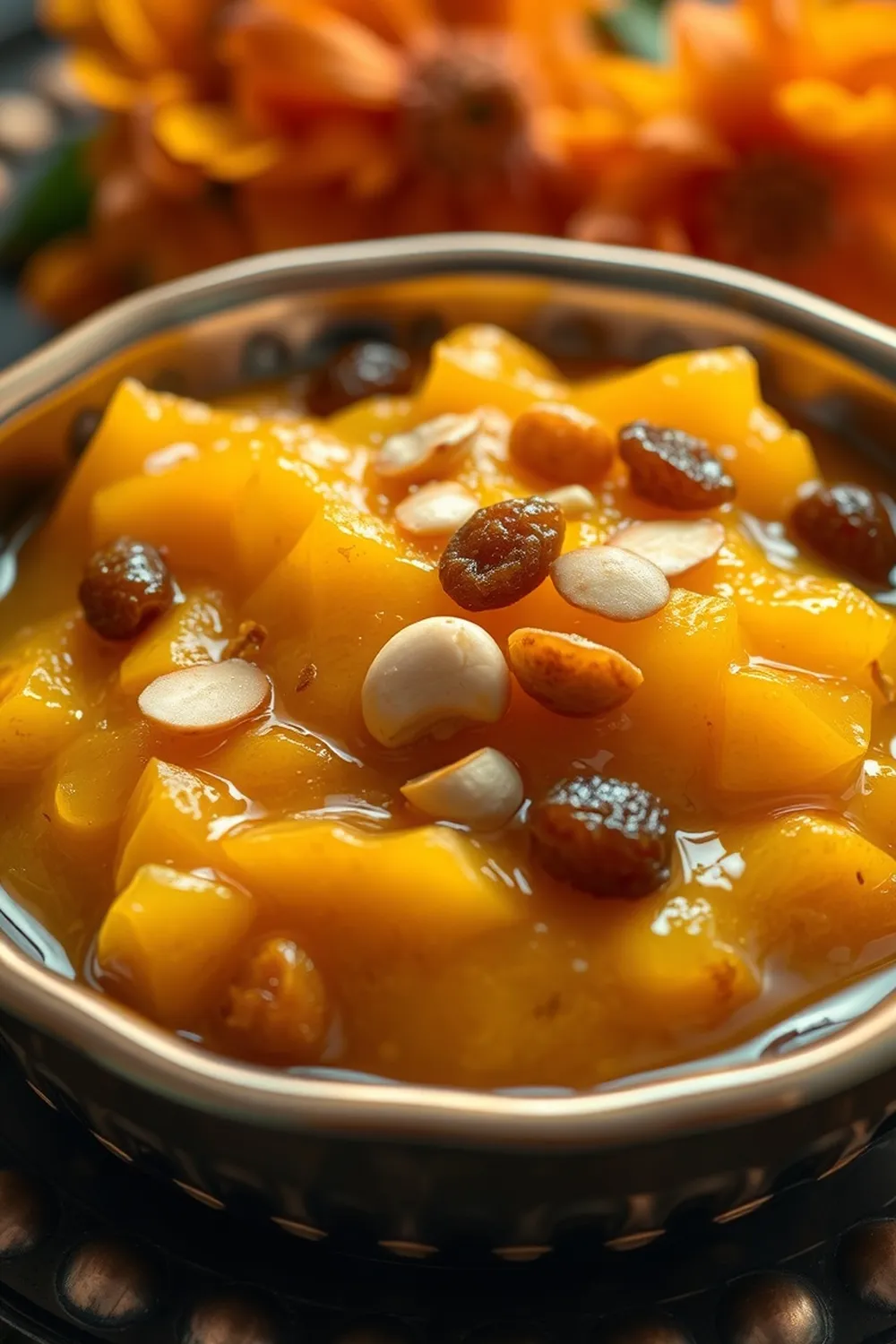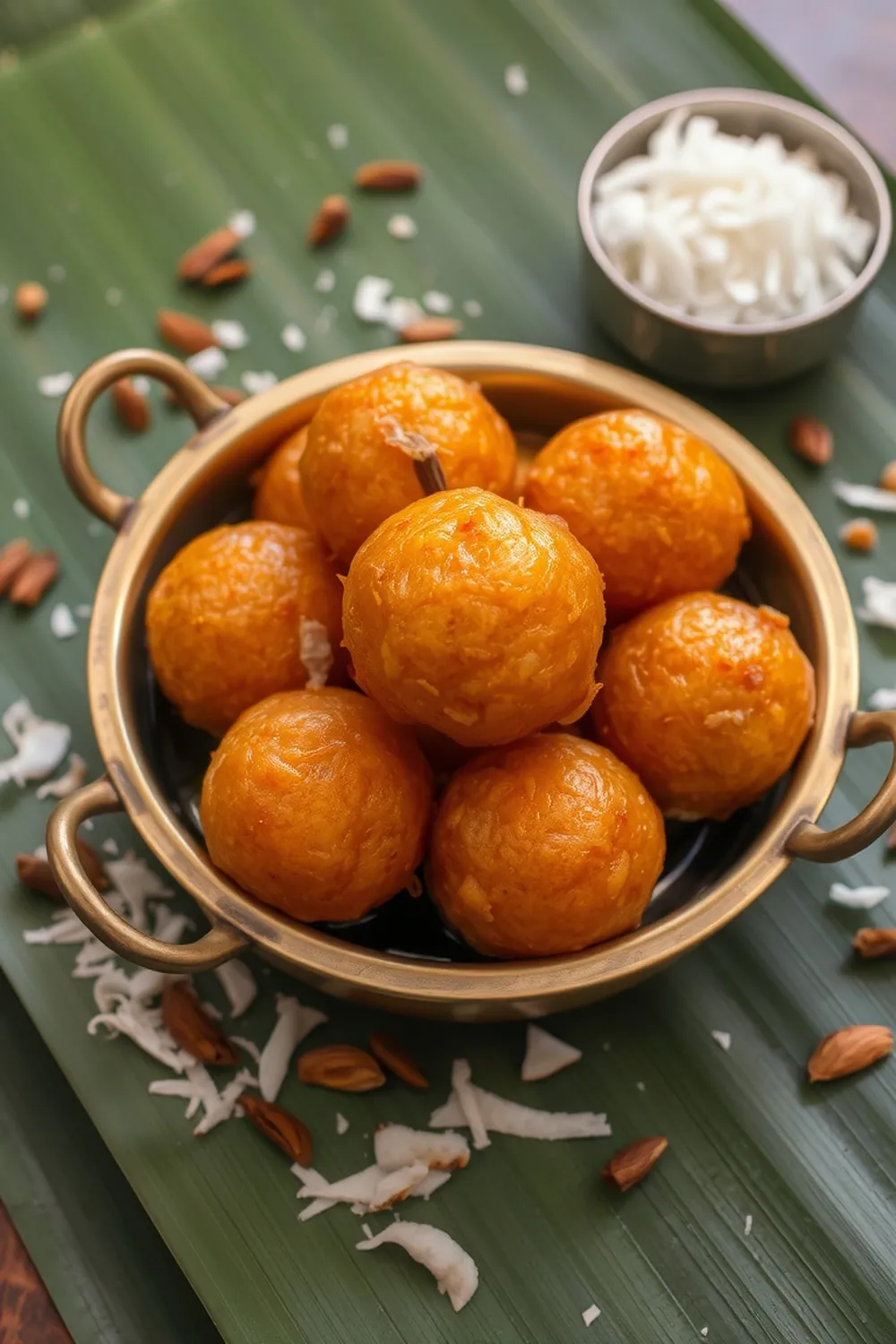- Heat ghee in a heavy-bottomed pan. Add sooji and cashews. Roast on low heat for 7-8 minutes, or until the sooji is lightly browned and the cashews are golden.
- In a separate pot, combine sugar and water and boil to create a sugar syrup.
- Add chironji, raisins, cardamom powder, and edible camphor (if using) to the roasted sooji mixture. Mix well.
- Carefully pour the boiling sugar syrup into the pan with the sooji mixture while stirring continuously to prevent lumps.
- Cook until the halwa thickens, absorbs all the liquid, and pulls away from the sides of the pan (3-4 minutes).
- Serve warm, garnished with nuts. Alternatively, set in a greased tray and slice when cooled.
- Calories:350 kcal25%
- Energy:1464 kJ22%
- Protein:5 g28%
- Carbohydrates:50 mg40%
- Sugar:30 mg8%
- Salt:10 g25%
- Fat:15 g20%
Last Updated on 6 months ago by Neha Deshmukh
Authentic Sooji Halwa Recipe – Cashew & Chironji Indian Dessert
Introduction
There’s just something about a warm bowl of Sooji Halwa that feels like a hug from the inside, isn’t there? It’s a classic Indian dessert, and honestly, one of the first things I learned to make when I started exploring my grandmother’s recipes. This particular version, with its generous helping of cashews and a hint of chironji, is extra special. It’s perfect for a cozy evening, a festive celebration, or just when you need a little sweetness in your life. Let’s get cooking!
Why You’ll Love This Recipe
This Sooji Halwa isn’t just delicious; it’s surprisingly easy to make! It comes together in under 20 minutes, and requires minimal ingredients. The combination of the nutty sooji, crunchy cashews, and the subtle floral notes of chironji is simply divine. Plus, it’s a guaranteed crowd-pleaser.
Ingredients
Here’s what you’ll need to create this comforting dessert:
- ?? cup Ghee (clarified butter)
- ?? cup Sooji (Semolina)
- 10-12 Cashews
- ?? cup Sugar
- 1.25 cups Water
- 1 teaspoon Chironji (optional)
- 2 tablespoons Golden Raisins (kishmish)
- Pinch of Edible Camphor (optional)
- ?? teaspoon Cardamom Powder
Ingredient Notes
Let’s talk ingredients – a few little tips can make all the difference!
Sooji (Semolina) Varieties
You can use fine, medium, or coarse sooji for halwa. I prefer medium sooji for this recipe – it gives a lovely texture. Fine sooji tends to become a bit mushy, while coarse sooji takes longer to cook. Roughly 100-120g of sooji is equivalent to 1 cup.
Ghee: The Importance of Quality
Ghee is key to a good halwa. It adds a richness and flavor that butter just can’t replicate. Use good quality ghee for the best results. Homemade is wonderful if you have it!
Cashews: Choosing & Roasting
Choose plump, good-quality cashews. Roasting them brings out their flavor and adds a delightful crunch. Don’t skip this step!
Chironji: A Unique Flavor Profile
Chironji adds a unique, almost almond-like flavor. It’s optional, but I highly recommend it if you can find it. It’s a bit of a specialty ingredient, but worth seeking out.
Edible Camphor: Traditional Use & Alternatives
Edible camphor (kachri) is a traditional ingredient, adding a cooling sensation. It’s optional and can be omitted if you can’t find it. If you’re curious, a tiny pinch is all you need!
Step-By-Step Instructions
Alright, let’s get down to business!
- Heat ghee in a heavy-bottomed pan over low heat. This is important – low and slow is the way to go!
- Add the sooji and cashews to the ghee. Roast for 7-8 minutes, stirring constantly, until the sooji is fragrant and the cashews turn golden brown. Keep stirring to prevent burning!
- In a separate pot, bring the sugar and water to a boil. Continue boiling until you have a one-string consistency syrup. (More on that in the FAQs!)
- Add the chironji, golden raisins, and cardamom powder to the roasted sooji mixture. Give it a good stir.
- Now, carefully pour the boiling sugar syrup into the pan with the sooji mixture. Be very careful – it will splatter! Stir continuously to prevent lumps from forming.
- Cook for another 3-4 minutes, stirring constantly, until the halwa thickens and starts to leave the sides of the pan. You’ll know it’s ready when it looks glossy and pulls away from the pan.
- Serve warm, garnished with extra nuts. Or, pour it into a greased tray, let it cool, and slice it into squares – perfect for sharing!
Expert Tips
A few little secrets to halwa success!
Achieving the Perfect Texture
The key is to roast the sooji properly. It should be fragrant and lightly golden, but not burnt. This gives the halwa its lovely texture.
Preventing Lumps in the Halwa
Pouring the sugar syrup slowly and stirring constantly is crucial. If lumps do form, don’t panic! Just keep stirring vigorously – they should eventually disappear.
Roasting Sooji to Golden Perfection
Don’t rush the roasting process. It develops the flavor and ensures the halwa isn’t sticky.
Variations
Want to switch things up? Here are a few ideas:
Vegan Sooji Halwa
Substitute the ghee with coconut oil or any other vegan-friendly oil. It won’t have quite the same flavor, but it will still be delicious!
Gluten-Free Considerations
Sooji is made from wheat, so it’s not gluten-free. However, you can use gluten-free semolina as a substitute.
Spice Level Adjustments
Feel free to add a pinch of saffron for a more luxurious flavor, or a dash of nutmeg for a warming spice.
Festival Adaptations (e.g., Diwali, Lohri)
During Diwali, my family loves to add a little bit of chopped almonds and pistachios for extra richness. For Lohri, we often make a larger batch to share with neighbors!
Serving Suggestions
Sooji Halwa is wonderful on its own, but it’s also lovely served with a scoop of vanilla ice cream or a dollop of yogurt. A sprinkle of chopped nuts always adds a nice touch.
Storage Instructions
Leftover halwa can be stored in an airtight container in the refrigerator for up to 3 days. Reheat gently on the stovetop or in the microwave, adding a splash of milk or water if needed to loosen it up.
FAQs
Got questions? I’ve got answers!
What type of sooji is best for halwa – fine, medium, or coarse?
I recommend medium sooji for the best texture. Fine sooji can get mushy, and coarse sooji takes longer to cook.
Can I make sooji halwa without cashews? What can I substitute?
Absolutely! You can omit the cashews altogether, or substitute them with almonds, pistachios, or even sunflower seeds.
What does edible camphor add to the halwa, and is it essential?
Edible camphor adds a cooling sensation and a unique aroma. It’s traditional, but not essential – you can easily make halwa without it.
How do I know when the sugar syrup has reached the correct consistency?
The syrup should reach a “one-string consistency.” To test this, take a small drop of syrup between your thumb and forefinger and gently pull them apart. If a single string forms, it’s ready!
Can this halwa be made ahead of time? If so, how should it be reheated?
Yes, you can make it ahead! Store it in the fridge and reheat gently on the stovetop or in the microwave, adding a splash of liquid if needed.










